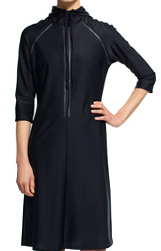I am not sure if sewing is offered as a subject in the Jewish curriculum of a Hebrew day school, but it sure is an important skill to acquire, especially among Jewish families. Hashem has blessed me with daughters, and I used to sew matching Mommy and daughter skirts when they were younger. I didn’t live in a community where affordable, modest Jewish clothing for girls could be easily found. So, my solution was to sew for my girls. It’s much easier to shop for modest skirts for women than for girls.
With the popularity of e-commerce in the past ten years, it has been much easier to shop for modest wardrobe for women and girls online, but the prices for these clothing have been horrific for my family budget. So, sewing remains an important resource to my family. Depending on the whims of the ongoing fashion trends, I was able to get modest long-sleeved shirts with fairly high necklines in the fall for me and my daughters. But as fashions change, so does the availability of modest apparel in the secular market. It’s good to know how to sew modest clothing. PERIOD.
I never knew there was easy accessibility to a set of clear, halachic standards for modest clothing until I stumbled upon a PDF booklet that one can download. This booklet, “
Dress In Accordance to Halachah”, is well-written and illustrated, in my humble opinion, and easy to follow. I am so grateful that I am able to find the reasons for why Jewish women need to cover up only certain areas of the body. For more details about the halachos, continue reading my subsequent posts.
 |
Neck above the collarbone
needs to be covered |
 |
Neck above uppermost spine bone
needs to be covered |
Our Sages have defined where the halachic neck ends and where the torso begins. Besides the collar bone on the front, the bone on the top vertebrae on the spine also needs to be covered, which explains to me, why most charedim choose shirts with collars over jewel (round) necklines. I suppose a tight mock neck will also satisfy the requirement.
Other considerations include choosing loose-fitting tops and skirts over tight-fitting ones that reveal the silhouette of your body. Hence, shirts, both woven and knit, with bust darts, pencil skirts and other long tight-skirts are out, even if they are without slits.
One of the advantages of being able to sew your own clothing is you can meet these halachic requirements based on an individual’s measurements. Most store-bought clothing, no matter, how modest, meet standard-sized clothing measurements. After surveying many modest clothings in Israel and USA, I have found that one has to be particularly careful about the details of the clothing. Jewel necklines on stretchy knits are a problem as they stretch after multiple wearing and laundering. If you have a sewing machine, you can add a mock neckband to it. If you don’t sew, you can purchase alterations from
ModestAnytime.com for a moderate fee. You can save money by adding extra length to your daughter’s skirts and tops instead of buying a new wardrobe. If you have large shirts from parents and grandparents that are headed towards recycling, you can reuse the fabric to make smaller shirts for your babies, toddlers and older children.
 |
| Tight fitting skirt |
 |
| Loose Fitting Skirt |
Besides sewing regular clothing for your family, you can save a lot by making modest swimwear for your girls. Material for swimwear is easily available and can be bought online. You can customize the fit to individual measurements. A swim dress pretty much looks like a dress, except that it is made with swimsuit material. Swimsuit material tends to be very stretchy, so if you are using it to make a dress, you will have to make sure it meets the halachic standards. I have seen Jewish swim dresses that look tight on the model (see left image). I have also seen swim dresses that can be made looser fitting like
the image on the right. After Tisha B'Av, iy"H, if Moshiach hasn't come yet, I hope to make a modest swim dress that meets Halachic standards and post my project here.
Knowing the basics of mending clothing is important as well, such as adding buttons, replacing zippers, and mending seams. However, sewing is not a trade relegated to the uneducated. First of all, you need to be able to read well, follow instructions, and understand many, many sewing concepts and terminology. You definitely need to have adequate mathematics skills in order to draft a pattern, amend standard patterns, purchase and cut the right amount of fabric, run a sewing business, etc. If you are talented at drawing, you can design clothing. You need to have some technical skills in order to operate and troubleshoot your sewing machine or serger. You need to acquire good research skills in order to find help online. There are tons of free tips and tricks offered by amateur sewers through blogs and videos. There are sewing classes offered at your local fabric and craft stores as well as online. There are also local and national sewing organizations that you can join. Women of all types form sewing communities online who support one another beautifully.
Sewing is a good skill to acquire in a Jewish family and a great investment!


















